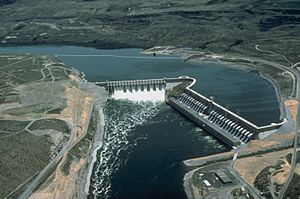Chief Joseph Dam facts for kids
Quick facts for kids Chief Joseph Dam |
|
|---|---|
 |
|
| Location | Douglas and Okanogan counties, Washington, United States |
| Coordinates | 47°59′43″N 119°38′00″W / 47.99528°N 119.63333°W |
| Construction began | 1949 |
| Opening date | 1979 |
| Operator(s) | |
| Dam and spillways | |
| Type of dam | Concrete-gravity, run-of-the-river |
| Impounds | Columbia River |
| Height | 236 ft (72 m) |
| Length | 5,962 ft (1,817 m) |
| Width (crest) | 22 ft (7 m) |
| Width (base) | 164 ft (50 m) |
| Spillway type | Service, gate-controlled |
| Spillway capacity | 6,030 m3/s (212,947 cu ft/s) |
| Reservoir | |
| Creates | Rufus Woods Lake |
| Total capacity | 516,000 acre-foot (636,000,000 m3) |
| Catchment area | 75,400 sq mi (195,285 km2) |
| Surface area | 13.1 sq mi (34 km2) |
| Power station | |
| Operator(s) | USACE |
| Type | Hydroelectric |
| Turbines | 27 x Francis turbines |
| Installed capacity | 2,620 MW |
| Capacity factor | 42.6% |
| Annual generation | 9,780 GWh (2009) |
| Website U.S. Army Corps of Engineers - Chief Joseph Dam |
|
The Chief Joseph Dam is a huge concrete dam on the Columbia River in Washington. It is about 2.4 kilometers (1.5 miles) upriver from Bridgeport, Washington. This important dam is managed by the U.S. Army Corps of Engineers. It helps create electricity for many homes and businesses. The power it makes is sold by the Bonneville Power Administration.
Contents
Building the Chief Joseph Dam
The idea for the dam started in 1946. It was first called Foster Creek Dam. The plan was to generate power and help with irrigation. In 1948, the project was renamed. It became Chief Joseph Dam to honor Chief Joseph, a famous leader of the Nez Perce people. He spent his last years living in exile nearby.
Construction and Power Generation
Building the dam began in 1950. The main dam and its water intake structure were finished in 1955. The first machines that make electricity were installed between 1958 and 1961.
Later, from 1973 to 1979, ten more power-generating machines were added. The lake behind the dam was also made 3 meters (10 feet) deeper. These changes made the dam much more powerful. Today, Chief Joseph Dam is the third largest producer of hydroelectric power in the United States.
Salmon Migration Blocked
One important thing to know is that Chief Joseph Dam does not have fish ladders. Fish ladders are special steps that help salmon swim upstream to lay their eggs. Because there are no fish ladders here, the dam completely stops salmon from traveling further up the Columbia River.
How the Dam Works
Chief Joseph Dam is a special kind of dam called a run-of-the-river dam. This means it cannot store a lot of water. Instead, the water that flows into it must flow out at about the same speed.
Water Flow and Power
Water coming from the Grand Coulee Dam (another big dam upstream) flows into Chief Joseph Dam. This water then needs to pass on to Wells Dam downstream. The dam has 27 large generators that use the water to make electricity. These generators can handle a huge amount of water, about 6,030 cubic meters (213,000 cubic feet) per second.
Spillway Gates
Sometimes, more water flows into the dam than can be used to make electricity. When this happens, special gates called spillway gates are opened. These gates let the extra water pass through safely. However, the Columbia River usually doesn't have too much water. So, opening the spillway gates is not very common at Chief Joseph Dam.
Rufus Woods Lake
The large body of water behind the dam is called Rufus Woods Lake. This lake stretches for about 82 kilometers (51 miles) up the river. It's a great place for outdoor activities. Bridgeport State Park is located right next to the dam, on the shores of Rufus Woods Lake.

